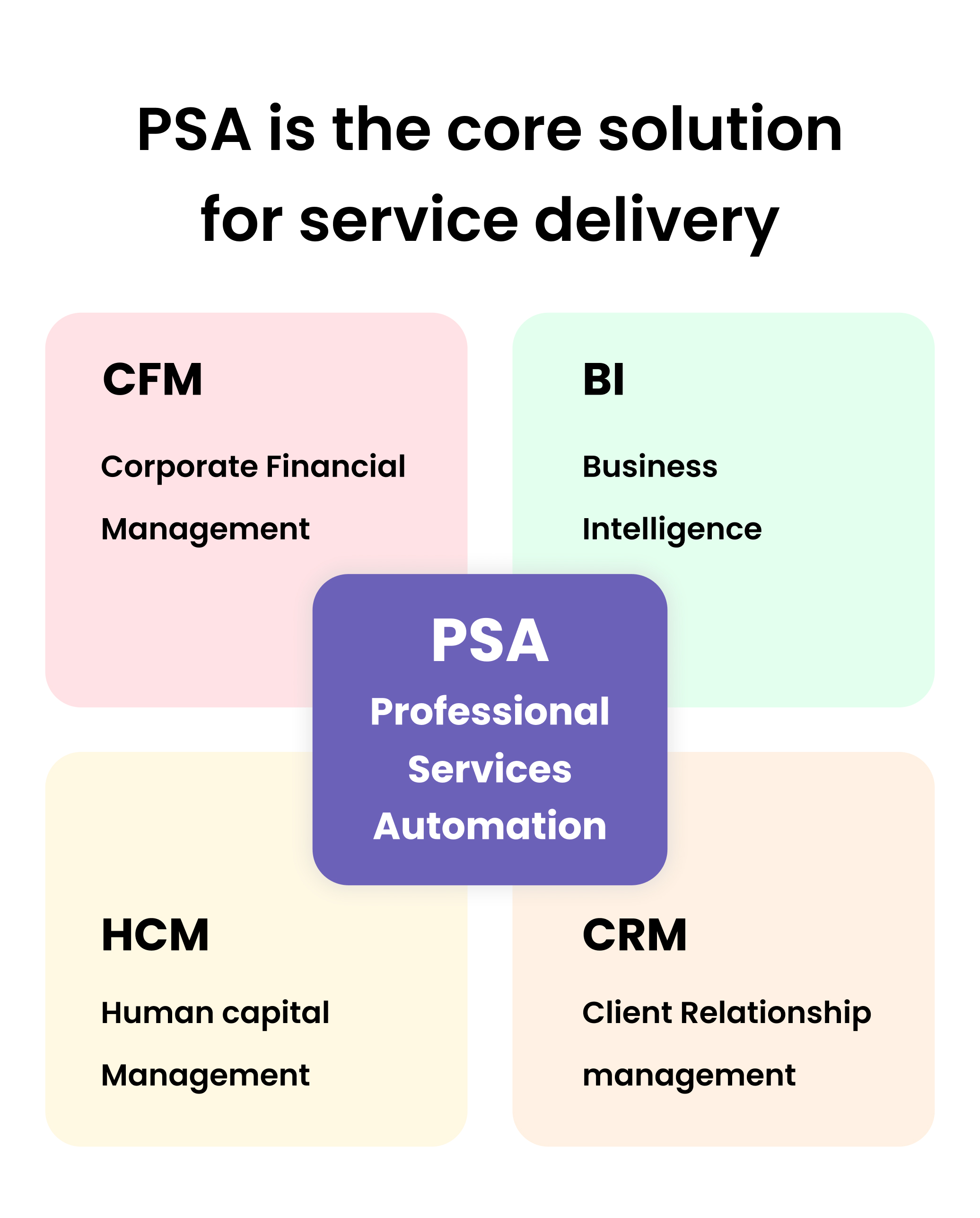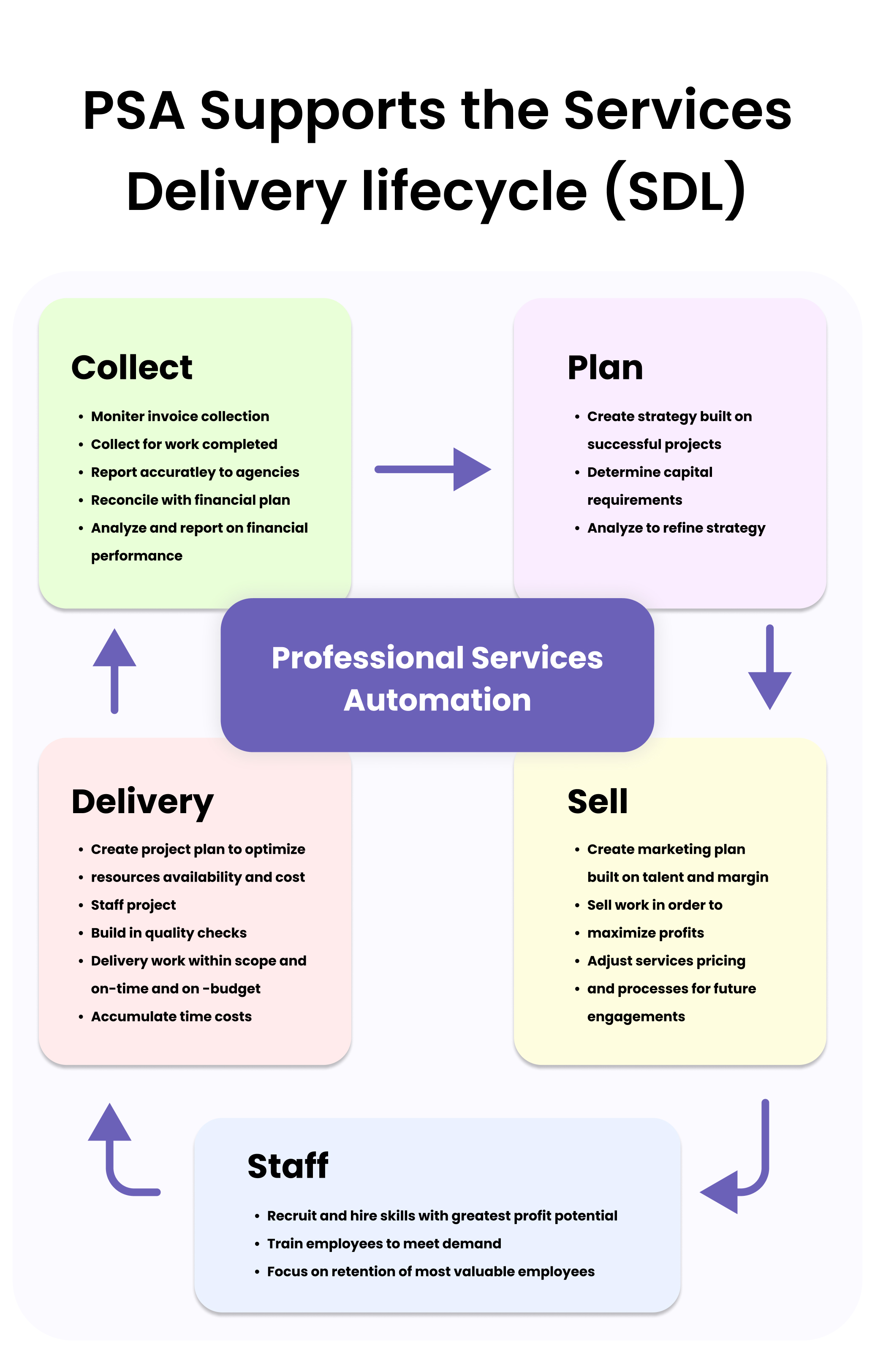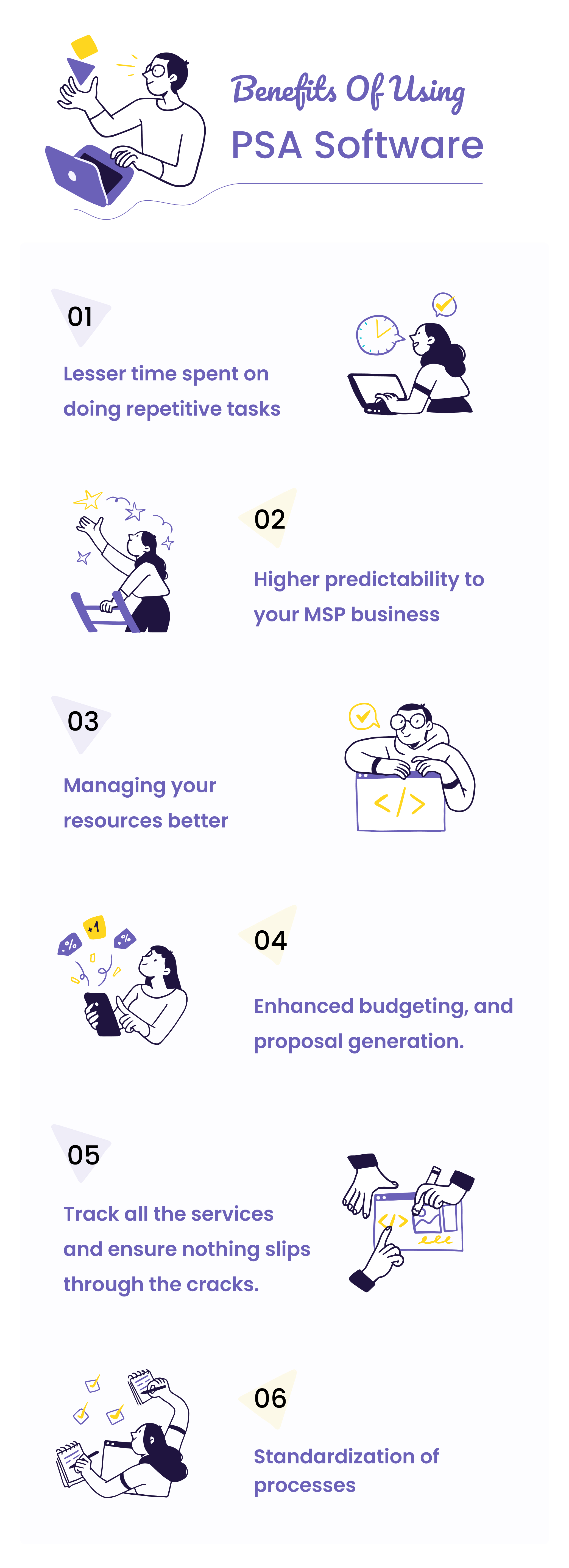What is Professional Services Automation?
Everything you need to know about PSA - Evolution, Functions, and Benefits
SIGN-UP FOR SUPEROPS.AIOver the past decade, professional services automation (PSA) has grown from just another arrow in a managed service provider’s quiver to the most basic weapon of choice. From handling a few processes and providing some form of cohesion, it has grown to become the encompassing hub that is essential to the internal and client-facing operations of an MSP. Today a PSA solution is among the first, and top, three software tools on a service provider's software purchase list; alongside an RMM.
But what makes PSA software so essential and mission-critical to a modern-day MSP? What is a PSA tool and what are the benefits to your company? We try to answer all such questions and more in this ready guide about PSA automation tools for MSPs.
What do you mean by PSA?
The idea behind a professional services automation tool is simple. It's a tool or suite of tools used to automate your business procedures.
SPI Research — a global organization to help Professional Service Organizations (PSOs) improve productivity and profit — in their 2017 PSA end-user survey defined professional services automation as “An integrated suite of applications used to increase operational visibility and improve process efficiency in the project- and services-driven organizations.”
The professional services we refer to here are the ones delivered by IT multi service providers or managed service providers. MSPs can use PSAs for automating processes for both working on their client systems and internal ones to make savings on timings and costs. For an IT MSP, a PSA can work as a central hub from which they can have a glance at their clients, internal applications, and overall profitability. Many critical applications that are used by their clients on their networks will also integrate with PSAs to provide easier and better functionality.

The difference between ERP & PSA
ERPs are the most common cloud-based tools organizations use and as PSAs are becoming common, people often get confused between these two.
So before we proceed further, let us understand the important similarities and crucial differences. Enterprise resource planning, known as ERP, is software that helps you manage your daily business activities. ERP improves your business by eliminating unnecessary bottlenecks and reducing processes altogether. PSAs meanwhile concentrate on improving your business processes - better resource allocation, time management, cost management, and more.
One common thing enumerated everywhere is that an ERP is used to manage tangible assets - so it’s better suited for manufacturing and supply chains. PSA meanwhile is more focused on intangible stuff like project and time management it's more suited for companies engaged in the services industry like our IT MSPs.
What are the main functions of PSA software?
A PSA tool can include many different uses, but important components or functions include opportunity management, engagement management, resource management, time management, project management, and cost management. Let’s take a deeper look into each of these:
Opportunity management: This function helps you to improve sales using client and sales data, prediction models, sales suggestions, and proposal generation. Some PSAs include a customer relationship manager (CRM) module to track these but others just do these functions separately or integrate with a CRM.
Engagement management: Any contact with the client is managed here. This includes sales pitches, contracts, any new requirements, and the understanding of deliverables. Here metrics like hours billed and total costare looked at but the hero metric must remain client satisfaction.
Resource management: This part of PSA does all the resource management including material and human resources. This is a key function impacting the MSPs operating profit. The work begins with capacity planning and proposal level and continues through the service delivery cycle with resource allocation, scheduling and managing hours, leaves, downtime (for servers, applications, etc), and more.
Time and expense management: It keeps a tab of time and expenses spent on any project for any client, including the human and material resources, here. Invoice management is also done under this function whereas the system automatically prepares and presents invoices to clients at predetermined times or on the basis of some trigger activities like the finish of a project.
Project management: Planning, execution, monitoring, control, and closing of projects for clients is done by this module or function.
Cost management: Predicting projected costs, then tracking actual costs, and conveying the profitability of a project is all done under this section. The cost management feature works actively to keep your margins intact even as service needs change.

Other professional services automation modules may include a helpdesk/service desk or ticketing solution, analytics and reporting, and, finally a dashboard to manage everything.
The benefits of using PSA Software
To grow, improve your company’s performance, and generate more revenue. As projects get managed better, costs dive and resource utilization kicks into a higher gear, your organization will surely see the benefits of putting a PSA solution in place. In fact, right after an RMM, PSA is the second most important weapon in the arsenal of any MSP.
Also with the number of cloud-based applications in use at any MSP nowadays, it’s essential that you have a hub from which you can easily access and manage all of those.

Here are some of the main things you will notice:
Less repetitive tasks mean lesser time wasted on them
A lot of the work that is done for managed service providers including MSPs is repetitive and often involves human intervention only at the starting stage and for report collection. Automating such processes either based on time or based on triggers can eliminate a lot of manual work.Higher predictability leads to fewer knee-jerk reactions Automation also means that we can actually have more checks, and scans and overall better monitoring will lead to better data collection which we can then use to create better data models. These data models can predict a lot of issues beforehand. This way we can avoid them altogether or predict possible failures and trigger alerts in advance which can prevent and bring down the amount of downtime.
Higher resource utilization means cost savings As many repetitive processes are automated, human resources are freed up to spend time on other critical tasks that demand their attention. This means that fewer people can cover more endpoints and networks and overall cost savings will be significant.
Tighter well-planned budgets, estimation, and proposal generations PSAs help in better resource and cost management — pre-planning, during, and post any project implementation. This means as time passes, an intelligent PSA will help you save a lot of money with better budgeting and cost management. They also use the data collated by them to improve the processes further and also provide more insights for MSPs and clients on how they can improve the overall business.
Keep a tab on all costs, billables, and profits in one-place PSA tools can handle customer data, billable hours, vacation requests, and inventory. It also creates schedules for all technicians and resources to help you utilize resources in the best possible manner and also to protect your margins all the time. Some PSA solutions also generate automated billing and send invoices to clients on their own.
Improved standardization, SLA management, and scalability A PSA will help you standardize processes for all workflows. This will make it easier to implement the same processes to multiple clients and tweaks to improve the processes across the board. This will improve the quality of service delivery, and reduce time and cost. This in turn helps you improve client relations effectively and scale faster and more efficiently. Also, as your MSP business grows beyond 4-5 clients, you will find it difficult to track all the requirements, processes, and billables for them on any manual system. Messed-up spreadsheets and missed entries must not become the reason for under-delivering on your service quality or missing an SLA-mandated deadline. To keep growing without missing a beat in your service, you require a proper PSA in place.
Evolution of PSA
Until the early 2000s, professional services companies seldom used process automation software. The financial suites were fundamental but other than that only some productivity tools and maybe some time tracking applications were used. Even as the clients of these companies took to PSAs, MSPs didn’t actually think about their use internally. They were still using a multitude of spreadsheets and manual work for service deliverables and to track billable hours, schedules and profits. This changed towards the beginning of the 2010s.
Growth, globalization, and regulatory pressure meant that MSPs had to employ IT solutions internally as they were doing externally. Independent software companies realized that as consulting and as MSP companies grew, they required solutions tailored to those needs and that’s how PSAs first started popping up for MSPs. Now the market is flooded with PSA solutions - some independent and some part of product suites but all boasting of compatibility and integration options with bucketloads of applications that are commonly used in the MSP-verse.
The PSA impact today
In the 2017 Service Performance Insight survey, SPI reported that over 80% of their surveyed PSA users use a cloud-based PSA solution. Also, more than half of them have integrated this with both their financial management solution and CRMs but less than 30% integrated it with a Human Capital Management system (HCM). The last bit is due to the fact that a lot of smaller companies don't actually use an HCM in the first place.
Companies have reported vastly improved profit margins (11%+ average), reduced profit loss due to revenue leakage by half (50% average), improved on-time delivery of services (9% average), more customer satisfaction, improved cost savings, and overall improved resource utilization post PSA adoption. Today there are a lot more PSA solutions available for MSPs and many other software solutions have added PSA capability.
Which is the best PSA for MSPs out there?
Ok since you’re here reading our article, we assume you know the answer already - It’s SuperOps.ai.
But we are not ones to boast without actual merit, in fact, we have published an entire comparison article which summarised our research and showcased our reasons for our rational victory in the comparison.
Here’re the key points from the study.
Our study involved leading PSAs available for MSPs and involved established names like Atera, Syncro, Kaseya, ConnectWise, Autotask, Naverisk, and newcomers like HaloPSA.
Our study began with the most obvious criteria — the cost of the solution. We are proud that with our super handy 21-day free trial with low cost and bundled functionalities, SuperOps.ai won this round while Halo, Atera, and Syncro took the next three spots. Meanwhile Naverisk RMM & PSA, Autotask PSA, ConnectWise manage & Kaseya BMS all shared the last spot due to their approach towards customized prices and still sharing prices via quotes.
Next up we had basic functionalities and integrations. We found that almost all our contenders delivered on the basic automation functionality but with differing results. Superops won that round with its intuitive, ever-learning automation capability.
In terms of additional functionalities, we noted that Atera, SuperOps.ai, Navrisk, and Syncro are RMM+PSA solutions that cover the most important two tools for any MSP. We found close combat up here as Atera claimed the top spot from us and HaloPSA joined us at the second spot. Naverisk and Syncro shared the next spot while Kaseya, ConnectWise, and Autotask shared the last one.
We then moved on to the look and feel a bit with a comparison of UI. We compared the UI bit based on how intuitive and friendly the interface was to check out and use. SuperOps.ai won the UI bit with Halo close on our heels. Atera and Syncro are improving while others are still stuck in their evolution cycle.
Then we calculated the average scores on G2 and Capterra reviews to rank the PSA software on the basis of “ease of use”. A bit surprisingly, and begrudgingly, we found ourselves fourth on the list. Atera won this round comfortably, while Naverisk and Syncro took the next spot. We were followed by Halo which had a clear lead over Kaseya followed by Autotask and ConnectWise. This was a learning moment for us and a lot of our updates over the past few months have been about fixing this ranking. You can try out the results of our efforts on our demo.
Then we ranked these based on their ability to create data reports and visualize them. SuperOps.ai was victorious once more based on its superlative data visualization capabilities and easy to use analytics. We were followed by HaloPSA, Syncro, Autotask, and Atera. ConnectWise, Kaseya BMS, and Naverisk shared the last spot.
It doesn’t matter if you’re the best if it's just plain difficult to implement your solution. In our final consideration we ranked apps based on their ease of implementation and also the level of support provided post implementation. As most of our contenders were cloud-based tools, we looked at training as a key step of implementation and found that most contenders did well in the training material.
HaloPSA, Autotask, and Kaseya provided in-person training but we felt it was a passe in the post-pandemic era. Kaseya and ConnectWise had no video training but Naverisk was worse as it only had training videos and nothing else.
In terms of support, HaloPSA, SuperOps.ai, Atera, Autotask, and Connectwise provide email, help desk, KB articles, phone, and 24/7 live chat support along with forums and FAQs. Syncro, Naverisk and Kaseya don’t have live chat support. Naverisk in fact has no chat support. Kaseya is worse with no email or help desk support or KB articles.
So with victories in multiple sections and a strong showing in most others, SuperOps.ai cleanly won this comparison followed by newcomer HaloPSA and veterans Syncro and Atera completing the top 4. Naverisk was an honorable mention in slot 5.
But you don’t have to believe this random article written by industry experts to make up your mind. No sir, you must try and see if we are right, or are we just some Jedi masterminds who know that once you take our 21-day free trial, you will come over to the SuperOps.ai’s side.
Try the next-gen PSA software for modern MSPs
All tools. One place. Make PSA a breeze with SuperOps.ai


